On This Page
Male and Female Black-Headed Grosbeak

- Black-headed grosbeak
- Scientific Name: Pheucticus melanocephalus
- Family: cardinal
- Length: 8 inches
- Wingspan: 12-1/2 inches
The males of this species get their distinctive color in their second year. “The male black-headed grosbeaks are fairly straightforward to identify,” says Emma Greig, project leader for the Cornell Lab of Ornithology’s Project FeederWatch. She suggests looking for a rufous-orange chest, bright white wing patch and the black head that is referenced in their name.
“Females and young males are trickier,” Emma says. “Look for their large beak, white eye stripes and warm rusty wash on the breast and flanks.” Black-headed grosbeaks are also on the larger side for songbirds, around 8 inches in length.
Check out the types of grosbeaks backyard birders should know.
Nest and Eggs

It takes a female black-headed grosbeak about four days to build a cup-shaped nest of twigs, grasses and pine needles. But after that, the male pitches in and shares incubation and feeding duties with his mate.
Located in the dense outer foliage of a tree or shrub, the nest is built of natural materials and hair and holds two to five green or blue spotted eggs.
What Do Black-Headed Grosbeaks Eat?

Their strong beaks give them an advantage on breaking through the tough shells of seeds, but they also use them to eat insects such as beetles and grasshoppers. Their beaks are so strong that black-headed grosbeaks have been known to crack open snail shells.
Monarch butterflies’ milkweed diet makes them bitter-tasting and toxic to many predators, but black-headed grosbeaks eat them anyway. These birds strategically wait several days between their monarch snacking sessions to give their bodies enough time to flush out the toxins.
“Attract black-headed grosbeaks to your yard by offering seed in a large feeder such as a hopper or platform feeder,” Emma says. “Black oil sunflower seed is the perfect seed type to give them.” They’re also voracious fruit eaters, even enjoying poison oak berries. Make your yard extra enticing with fruiting trees and bushes such as crabapple, elderberry and raspberry (if you’re willing to share).
Black-Headed Grosbeak Song
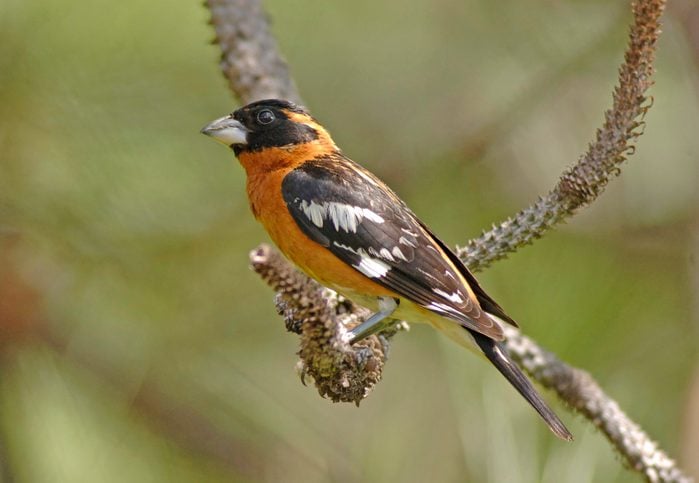
A black-headed grosbeak’s song is similar to an American robin’s but at a faster pace. What really makes this species stand out, however, is who is doing the singing.
“Female black-headed grosbeaks actually sing!” says Emma. “Usually the female black-headed grosbeak has a shorter version of the male’s song, but sometimes they can sing a full, male-like song. Perhaps they’re trying to get their mate to pay more attention to them by mimicking the presence of an intruding male.”
Bird songs provided by the Cornell Lab of Ornithology.
Black-Headed Grosbeak Habitat and Range

While the East and Midwest have rose-breasted grosbeaks, head across the Great Plains region and you’ll meet their orange-hued cousins, the black-headed grosbeaks.
If you’re in their range, look for black-headed grosbeaks in deciduous trees and open woodlands, but they’re usually willing to stop by backyards during spring and fall migration.
Black-headed and rose-breasted grosbeaks’ ranges overlap in the Great Plains, and these two species are closely related enough that they sometimes interbreed with each other to create hybrids. These combo birds can end up looking like either parent or a mix between the two.
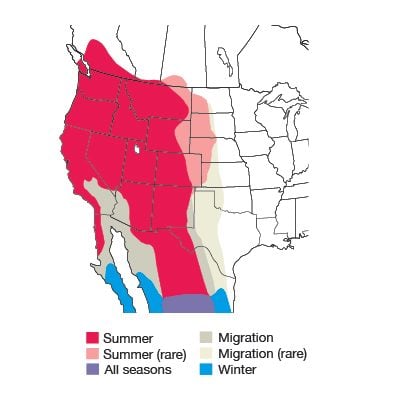
Range maps provided by Kaufman Field Guides, the official field guide of Birds & Blooms.
About the Expert
Emma Greig is the project leader of Project FeederWatch, a citizen science program, for the Cornell Lab of Ornithology. Emma holds a Ph. D. from the University of Chicago and previously was a postdoctoral associate in Macaulay Library.
Sources
- National Geographic – black-headed grosbeak
- National Audubon Society – black-headed grosbeak
- All About Birds – black-headed grosbeak
- BirdNote
- University of California-Berkeley research
- American Bird Conservancy – grosbeaks of North America
- eBird – rose-breasted grosbeak x black-headed grosbeak hybrid
- The Texas Breeding Bird Atlas – black-headed grosbeak
- Black Hills Audubon Society
- Montana Field Guide – black-headed grosbeak
- Sacramento Audubon Society

While admiring a stand of coneflowers in the garden you may be luck enough to notice a skipper butterfly. They’re small, shaped like a narrow triangle, and can be found crawling across a bloom. Leaning in closer and you’ll see that it has a fuzzy body and an orange-and-black wing pattern. When it zooms into the air, it whirls around in fast, erratic zigzags before resting on another flower.
On This Page
Types of Skipper Butterflies
Skippers belong to the order Lepidoptera, the great worldwide group that includes all the butterflies and moths. At one time they were considered a third category within the order, but most experts now agree that skippers are butterflies. They make up a distinctive family called the Hesperiidae.

Several features set the skippers apart from other butterflies. They have stout bodies, big heads and very rapid, erratic flight. Smaller than the average butterfly, most are not brightly colored. They wear tones of brownish orange, black or gray.
Skippers have one big thing going for them: variety. The United States and Canada have well over 200 species of skippers, which make up about a third of the butterfly diversity in the two countries. With so many kinds, it’s challenging to identify them. Some butterfly-watchers joke that they’re called skippers because it’s easier to just skip them! But a few are readily recognizable. It’s also easy to separate the skippers into two major groups: spread-wings and grass skippers.
Check out the best tips for watching and photographing butterflies.
Spread-Wing Skipper Butterflies

Almost 80 species of spread-wing skippers are regularly found in the U.S. and Canada. Several others, including some with bright colors, rarely wander in from Mexico.
Spread-wings usually sit with their wings stretched out to the sides (as the name suggests). They also hold them above their backs, the same postures as most typical butterflies. Mostly black, dark brown or gray, they usually have a wingspan of less than 2 inches. This makes them easy to overlook.
An attention-grabbing exception is the silver-spotted skipper, a common flier from coast to coast in the U.S. and parts of southern Canada. It has a wingspan of almost 2 inches and a golden stripe across each forewing, but its most identifying mark is a big silver-white spot on the underside of each hindwing.
Caterpillars of silver-spotted skippers feed on locust trees, wisteria vines and many other plants, while adults visit a wide variety of flowers.

Another spread-wing seen all across the continent is the common checkered-skipper. It’s very small (with a wingspan of just over an inch). Bold black-and-white checkering separates it from other butterflies in yards and gardens. Adults fly fast and low, often landing on bare spots on the ground and visiting blooms such as clover or marigolds.

The long-tailed skipper, more of a southeastern specialty, is common from Texas to Maryland. Long tails on the hindwings and a blue-green sheen on its body and wing bases make it easily recognizable. More migratory than most skippers, it sometimes wanders north, even reaching New England and the Great Lakes.

Other groups such as duskywings, cloudywings or sootywings are much harder to identify, all being blackish with white dots. It’s usually enough of an accomplishment just to recognize them as spread-wing skippers.
Grass Skipper Butterflies

Found everywhere from the Arctic to the tropics, grass skippers make up the most diverse group within the family. More than 120 species of grass skippers live throughout the U.S. and Canada, so at least a few kinds can be found in any given region.
Even among this varied throng, some things are consistent. Most species of grass skippers are small, and a few are truly tiny. The majority are some shade of orange with darker markings, but some are gray or black. Most have a narrow triangular appearance when sitting and they often adopt a posture called the jet-plane position.
In this posture, they hold their hindwings flattened out to the sides and their forewings raised above their backs, which is reminiscent of the shape of certain fighter jets. It’s appropriate, too, because most grass skippers are amazingly fast fliers.
The grass skipper butterfly group got its name because the caterpillars use grasses or related plants as their host plants. Some are specialized to feed only on certain native grasses or sedges and, as a result, a few have become rare or endangered as the natives are crowded out. But others are more adaptable, feeding on a variety of grasses, and they continue to be common.

For example, Peck’s skippers are quite numerous across the northern and central states because Kentucky bluegrass and other widespread grasses are their host plants.
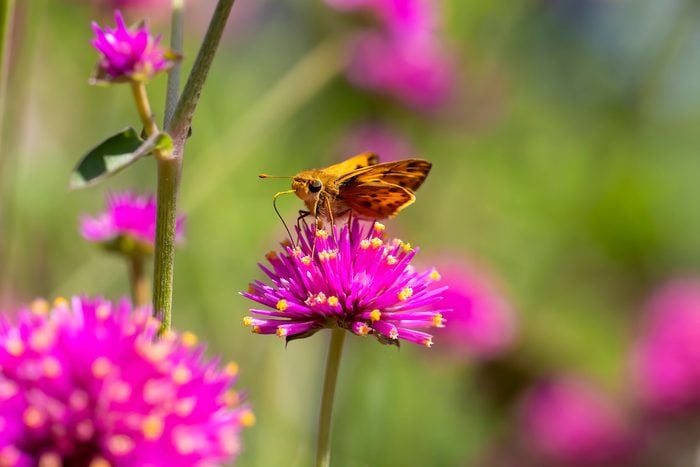
The fiery skipper has adapted to feed on Bermuda grass, a popular turf grass that was introduced to North America from Africa (not Bermuda) in the 1750s. Now abundant across the South, fiery skippers wander northward every year, sometimes even being spotted around the Great Lakes.
How to Attract a Skipper Butterfly

Flowers that attract other butterflies, such as coneflowers, asters, milkweeds and many more garden favorites, also attract adult skippers.
Host plants for spread-wing skipper caterpillars are so varied that the best general advice for most gardeners is to include as many native plants as possible in your landscaping. For the grass skipper group, try researching native grasses in your area and adding some as accent plants in your garden. A native plant nursery or your state or county extension service should be able to point you to some good choices.
Finally, it’s important to avoid using insecticides, which would kill skippers and other pollinators. Although they’re often overlooked, skippers are fascinating. Watch closely in your garden and you’re likely to discover that some of these little butterflies are regular visitors.
Next, check out more beautiful butterfly pictures you HAVE to see.
Why Trust Us
For nearly 30 years, Birds & Blooms, a Trusted Media Brand, has been inspiring readers to have a lifelong love of birding, gardening and nature. We are the #1 bird and garden magazine in North America and a trusted online resource for over 15 million outdoor enthusiasts annually. Our library of thousands of informative articles and how-tos has been written by trusted journalists and fact-checked by bird and garden experts for accuracy. In addition to our staff of experienced gardeners and bird-watchers, we hire individuals who have years of education and hands-on experience with birding, bird feeding, gardening, butterflies, bugs and more. Learn more about Birds & Blooms, our field editor program, and our submission guidelines.
How to Get Rid of Snow-on-the-Mountain Plants

“I’ve been fighting snow-on-the-mountain for more than 40 years, but now it’s taken over my flower bed. What should I do?” asks Birds & Blooms reader Janet Painter of Wanesburg, Ohio.
Horticultural expert Melinda Myers says, “Many of our worst weeds and invasive plants were once prized landscape plants due to their vigor and ability to withstand adverse growing conditions. This allowed them to take over garden beds and nearby natural spaces. Timing and persistence are key to managing this plant, which also goes by goutweed, bishops weed and Aegopodium podagraria.
Consider removing any desirable plants from the garden bed and potting them up for the growing season. Monitor these to make sure no roots or rhizomes of the snow-on-the-mountain have hitched a ride with them. Then edge the garden bed to prevent the plants from spreading into the nearby lawn or garden and any you may have missed providing needed nutrients to the covered plants. Cover the bed with black plastic or black landscape fabric and secure the edges.
Leave it in place for at least one growing season. I suggest planting annuals in the garden the next year in case some of the roots and rhizomes survive and you need to repeat this process. Regular mowing can also slow the spread of this plant, and repeat applications of a total vegetation killer can also help. But it takes years, as you discovered, to eliminate this plant.
Follww these expert tips to get rid of lily of the valley.
Snow-on-the-Mountain Spreads by Rhizomes
Really vigorous growers are not ideal near less vigorous ones—they claim the entire bed and require more work. Choose plants that cover at the same rate. Spreading type affects growth, too. Some, like bugleweed, spread indefinitely, but because of its shallow roots, it’s easy to control. Snow-on-the-mountain, on the other hand, spreads by rhizomes that are almost impossible to keep in bounds.
Stop bindweed from taking over your garden.
About the Expert
Melinda Myers is the official gardening expert for Birds & Blooms. She is a TV/radio host, author and columnist who has written more than 20 gardening books. Melinda earned a master’s degree in horticulture from the University of Wisconsin-Madison.
Why Trust Us
For nearly 30 years, Birds & Blooms, a Trusted Media Brand, has been inspiring readers to have a lifelong love of birding, gardening and nature. We are the #1 bird and garden magazine in North America and a trusted online resource for over 15 million outdoor enthusiasts annually. Our library of thousands of informative articles and how-tos has been written by trusted journalists and fact-checked by bird and garden experts for accuracy. In addition to our staff of experienced gardeners and bird-watchers, we hire individuals who have years of education and hands-on experience with birding, bird feeding, gardening, butterflies, bugs and more. Learn more about Birds & Blooms, our field editor program, and our submission guidelines.
In addition to selecting the right types of bird feeders, where you place the feeders in your yard can effect how successful you are with your backyard bird feeding. In order to attract the most birds, follow these simple tips on bird feeder placement.
Learn how (and how often) to clean bird feeders.
On This Page
Measure Distance From Windows

To prevent window strikes, place bird feeders either within 3 feet of your windows or more than 10 feet away from them. You can even try a window bird feeder to see birds up close. If the birds hit your window from within 3 feet they will likely not be going fast enough to hurt themselves. If your feeders are more than 10 feet away, they birds should have time to make adjustments and avoid your windows. This won’t completely stop window strikes but it should help.
Here’s how to help a bird that flew into a window.
Use a Strong Bird Feeder Pole

If you are using a bird feeder pole or shepherd’s hook to hang your feeders, be sure that it’s large and sturdy enough to hold the weight of the feeders you plan to hang without bending.
Add a Baffle

To avoid issues with chipmunks, squirrels, raccoons, and other critters, consider using a baffle. Remember, in order for a baffle to be successful, your feeders should be places at least 10 feet from the closest object that squirrels could jump from. The top of the baffle should sit at least 4 feet off the ground.
Do safflower seeds deter squirrels?
Hang Your Bird Feeder High

Be sure to hang your feeders high enough that ground predators can’t jump up and catch the birds on your feeders. This bird feeder placement tip is especially important if you live in an area that has many feral cats.
Plant Shrubs Nearby

Provide some nearby cover for your birds to hide should a hawk or other predator come by. Groups of small shrubs tend to be a good choice. Psst—find out what foods hawks eat.
Should You Hang a Bird Feeder Near a Birdhouse?
“My 8-year-old daughter was curious if placing a birdhouse next to a bird feeder is a good idea. But she wondered if the birds living in the house would prevent others from visiting the feeder?” asks Birds & Blooms reader Ginger Cooper.
Birding experts Kenn and Kimberly Kaufman say, “That’s a smart observation from your daughter. During the breeding season, most bird species don’t like having other birds—of any kind—too close to their nests. So if a pair chose a nest box right next to a feeder, they might try to drive away all the potential visitors, or they might be so distracted by all the traffic that they wouldn’t succeed in raising their own young.
We recommend placing nest boxes at least 20 feet away from feeders for small birds such as house wrens—and even farther away for birds like bluebirds or tree swallows.”
About the Experts
Kenn and Kimberly Kaufman are the official birding experts for Birds & Blooms. They are the creators of the Kaufman Field Guide series and they speak and lead birding trips all over the world.
Why Trust Us
For nearly 30 years, Birds & Blooms, a Trusted Media Brand, has been inspiring readers to have a lifelong love of birding, gardening and nature. We are the #1 bird and garden magazine in North America and a trusted online resource for over 15 million outdoor enthusiasts annually. Our library of thousands of informative articles and how-tos has been written by trusted journalists and fact-checked by bird and garden experts for accuracy. In addition to our staff of experienced gardeners and bird-watchers, we hire individuals who have years of education and hands-on experience with birding, bird feeding, gardening, butterflies, bugs and more. Learn more about Birds & Blooms, our field editor program, and our submission guidelines.
On This Page
How to Grow Allium Flowers

- Allium hybrid
- Zones: 4 to 8
- Attracts: bees and butterflies
- Light needs: Part sun to full sun
- Soil: Well-draining
- Cultivars to try: Medusa, Summer Beauty and Summer Peek-a-Boo alliums are worth checking out.
It’s impossible to quickly summarize allium flowers, a gigantic group of perennial, edible and ornamental plants with different sizes, shapes, colors and bloom times. But it’s easy to sing their praises.
Alliums, members of the onion family with about 1,000 species, grow in most climates and have bloom times from early spring through fall and later in mild climates. Most are drought resistant and grow best in full sun, although some tolerate shade.
They can tolerate hot summer weather, with long-lasting blooms that attract butterflies. Plus, deer and rabbits tend to leave alliums alone.
“They’re durable, long-lived, trouble-free for the most part, and deer resistant,” says Brent Horvath, president of Intrinsic Perennial Gardens in Hebron, Illinois, who selects and breeds alliums and other perennials. “They’re up-and-coming in popularity, too.”
Two main types of alliums—bulbs and clump-forming—each have their own characteristics. If you plan carefully, it’s possible to have an allium blooming from early spring to late in the year.
Garden tip—you may need to learn to be comfortable with botanical Latin because many alliums don’t carry a consistent common name.
When to Plant Allium Flower Bulbs

Because allium bulbs need a cold dormant period to flower, they must be planted in the fall. They shoot up in spring, flower, dry up and then go dormant. Bulbs may rot in wet poor-draining soils, so consider planting them in rock gardens or soils that don’t retain water.
Many gardeners are familiar with spring-flowering allium bulbs, especially the attention-grabbing big ball types, such as Globemaster, Gladiator, Purple Sensation and the showstopping 8-inch-wide flower head of Allium giganteum.
Other bulb favorites include fireworks-shaped alliums such as tumbleweed allium (A. schubertii) or Star of Persia (A. cristophii); low-growing Turkestan onion, such as Ivory Queen (A. karataviense); and drumstick alliums with slender stalks and elongated small flower heads that resemble a drumstick.
Check out the top 10 biggest blooms for your flower garden.
Clump-Forming Allium Flowers

This type of allium flower grows from tiny bulbs or fibrous roots attached to underground stems called rhizomes. These alliums, such as common chives, parade their blooms after spring and can be planted from spring to fall. They tolerate soils that retain more water.
Their lively foliage adds texture to a garden. Some have twisted or curly leaves while others are straplike. Leaf colors vary from bright Kelly green to gray-blue.
Millenium allium, selected as the 2018 Perennial Plant of the Year by the Perennial Plant Association, is a clumping type with 10-to-15-inch deep-green leaves. Each 2-inch-wide rosy purple spherical puff contains dozens of tiny individual flowers that become pollinator magnets. It will add jolts of color and texture to your summer garden. This hybrid genus doesn’t self-seed, so you won’t have unwanted volunteers.
Allium Flower Landscaping Tips
Alliums work well in many garden settings. Brent is particularly fond of clump-forming alliums. “They’re increasing in popularity, and they’re great foliage plants,” he says. He mixes two or more types in different sizes and colors. His breeding produced 18-inch-tall Windy City, with violet-colored flowers, which he pairs with 10-inch-tall Summer Beauty, sporting lavender flowers on stems up to 20 inches tall.
The Lurie Garden in Chicago uses Summer Beauty in mass plantings. “It’s hard to beat for foliage, and it looks good from the time it emerges in April to the end of the year,” Brent says.
Clumping types easily fill spaces in the front or middle of a perennial and shrub border.
Allium bulb leaves often begin to die even before the blooms open, so interplant bulbs with other perennials to hide the unsightly foliage. Once the bloom fades, consider leaving the remaining brown stalk and flower head intact to add unusual texture.
More simple tips for alliums:
- Grow in full sun for bigger blooms, stronger stems and more reliable flowers.
- Plant in well-draining soil to avoid bulb rot.
- After flowering, keep foliage intact to allow the bulb to recharge for next season.
Check out more purple flowers to grow in your garden.
Top 10 Allium Flowers to Grow
Globemaster
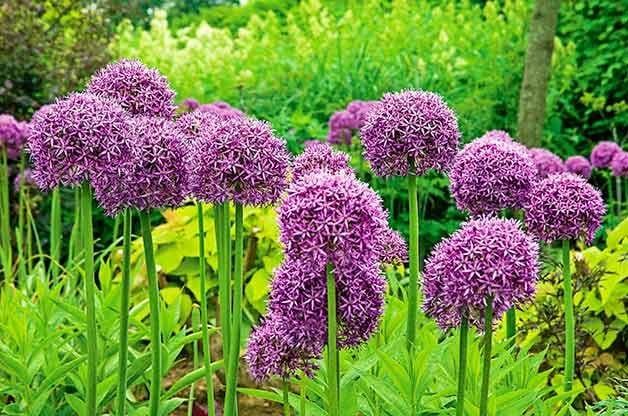
Allium ‘Globemaster’, Zones 4 to 8
A hybrid cross between two species, Globemaster is considered one of the best and most beloved of the tall spring-blooming types. Purple spheres covered with hundreds of individual florets grow 8 to 10 inches wide, and look fabulous in a vase. Look for bigger bulbs for larger flowers.
Why we love it: The sturdy 2- to 3-foot stems add vertical interest, and stand up to wind and rain.
Ambassador

Allium ‘Ambassador,’ Zones 4 to 8
Many spring-blooming alliums bear similar mug shots, but they all behave differently. Ambassador is one of the tallest, at 3 to 4 feet, with 7-inch, rich purple globes. Plant a few varieties of alliums that bloom in succession for continual blooms. Foliage tips tend to turn brown before the flowers open.
Why we love it: It attracts bees and other pollinators during its long five-week bloom period.
Persian Shallot

Allium stipitatum ‘White Giant,’ ‘Mount Everest’, Zones 4 to 8
For white counterparts that look stunning planted near the tall purple spring-blooming types, check out White Giant, which grows 3 to 4 feet tall with 6- to 8-inch-wide flower clusters, or Mount Everest, with 36-inch-tall stems with 4-inch-wide blooms.
Why we love it: Bright white bloom clusters resemble fluffy snowballs on stems. Use these beauties to add a whimsical twist to arrangements.
Millenium
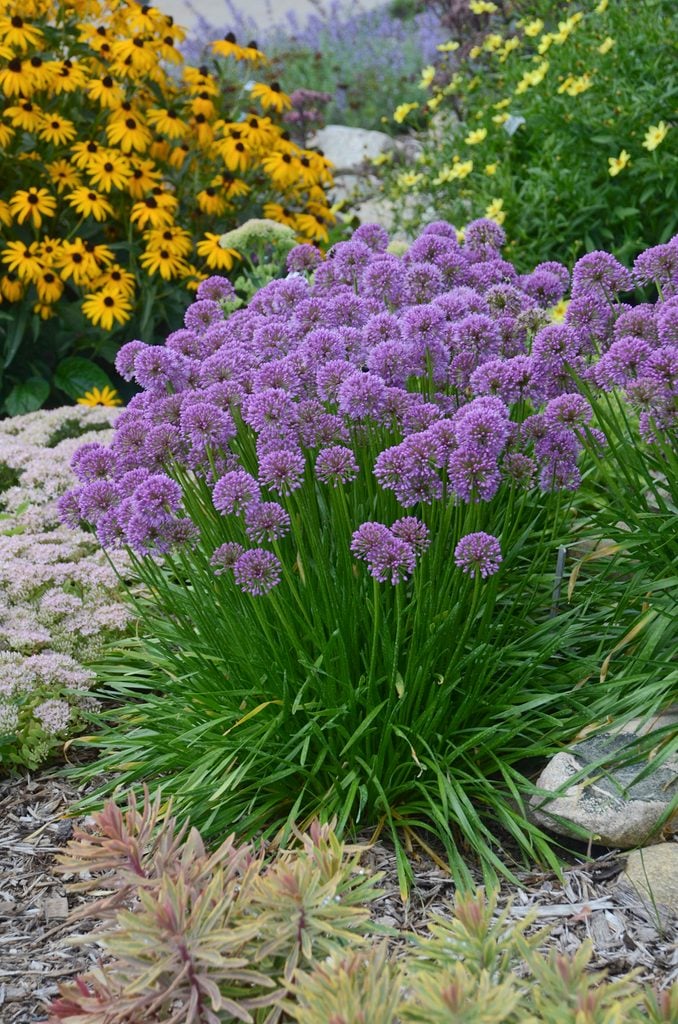
Allium ‘Millenium’, Zones 4 to 8
Low-maintenance Millenium alliums feature dozens of fragrant, deep pink, spherical flowers that bloom from mid to late summer. The foliage is thin, glossy and dark green in color. Plant them 10 to 15 inches apart and divide the fibrous root system in spring or fall.
Its rosy purple globes are just 2 inches wide, and its low stature makes it easy to tuck into almost any garden.
Why we love it: This award winner was dubbed 2018 Perennial Plant of the Year by the Perennial Plant Association.
Fireworks

Allium schubertii, Zones 4 to 8
This allium explodes like fireworks with a wispy 9- to 12-inch-wide round, rosy purple bloom cluster composed of 50 to 100 shooting florets. The entire flower head falls off the stem when it dries out, rolling and scattering seeds in the wind like a tumbleweed—the reason it’s sometimes called a tumbleweed onion.
Why we love it: Use the dried flower heads and stems in arrangements; you can even spray-paint them for more color!
Yellow-Flowered Garlic

Allium Flavum, Zones 4 to 8
It’s not a common sight in American gardens, but this delicate allium is an easy plant to grow for late spring and early summer. Fragrant yellow umbels perch on wiry, thin stems above blue-green leaves. Remember where it’s planted; until it flowers the slender leaves may resemble grasses.
Why we love it: This bulb will naturalize in locations where it’s doing well, creating a patch of lemon yellow flowers.
Ivory Queen

Allium karataviense ‘Ivory Queen’, Zones 4 to 8
Ivory Queen is a great front-of-the-border allium with thick bluish green leaves that are almost as attractive as the 3-inch white globes above it. If you can’t find this cultivar, stick to the straight species, which has pale pink umbels instead of snowy white.
Why we love it: Less stem means more flower power closer to the ground.
Star of Persia

Allium cristophii, Zones 4 to 8
This plant’s name provides a hint about its origin—the dry soils of ancient Iran. The amethyst-pink florets are larger than those of many other varieties of alliums. It’s good for rock gardens, and is an ideal short border plant.
Why we love it: The florets have a silvery sheen, so the 8- to 10-inch-wide spherical flower seems to sparkle.
Drumstick

Allium sphaerocephalon, Zones 4 to 8
It’s hard to say just how the drumstick allium got its common name— it does not really resemble either a chicken drumstick or the instrument used for drumming. This early summer bloomer may resemble a slender grass until the 1-inch-wide, egg-shaped composite flowers start blooming in midsummer.
Why we love it: The clusters look like hefty and colorful clovers, with bicolor florets that change from green to purple.
Blue Globe Onion

Allium caeruleum, Zones 4 to 8
Try to remember where you’ve planted blue globe onion. Slender leaves clinging to wiry stems may resemble grasses or garden chives until they’ve fully matured. The 1-inch-wide umbels open to reveal a surprise bouquet of cornflower blue florets.
Why we love it: That cool blue color! And butterflies love it, too.
More Unique Allium Varieties

Also look for alliums with unusual forms or colors. One of the weirdest is Hair, which has tiny frizzy green blooms that make it look as if it’s having a bad hair day; it reseeds readily. Allium bulgaricum, a Mediterranean native that goes by several botanical names, carries drooping florets that spray out attractively from the central stem. At over 3 feet tall, it makes a statement.
Add yellow with varieties of Allium moly, which has late-spring-to-early-summer loose yellow flowers and foot- tall foliage; it self-seeds too.
True blue, an unusual garden color, shows off with Allium caeruleum (also called A. azureum) and the delicate blue of Allium caesium.
Allium Flower Growing Restrictions
Gardeners in parts of Idaho and Oregon cannot buy alliums grown outside of their quarantined regions because of a need to prevent a fungal onion disease known as white rot. The disease threatens the region’s extensive commercial onion crop because it can live in the soil for up to 30 years. Only seeds and locally produced bulbs can be grown in those areas.
About the Experts
Brent Horvath is a plant breeder and the president of Intrinsic Perennial Gardens. He earned a degree in ornamental horticulture from Oregon State University.
Sources
On This Page
Why Are Hummingbirds So Territorial?

A hummingbird is a wonder to behold as it dances in the air to sip sweet nectar from flowers. You might imagine that such a delicate lover of sweetness would be among the most peaceful creatures in the world. In reality, whenever two or more hummingbirds are present, things can get a little tense. The feisty birds zoom about, sparring in midair or chasing each other with chattering cries—relentless in their desire to defend their spaces. Usually when you see a male hummingbird at a feeder, you only see one. And there’s a reason for that. Male hummingbirds are territorial. Here’s what you need to know about this common hummingbird behavior.
Hummingbirds Compete for Nectar Sources
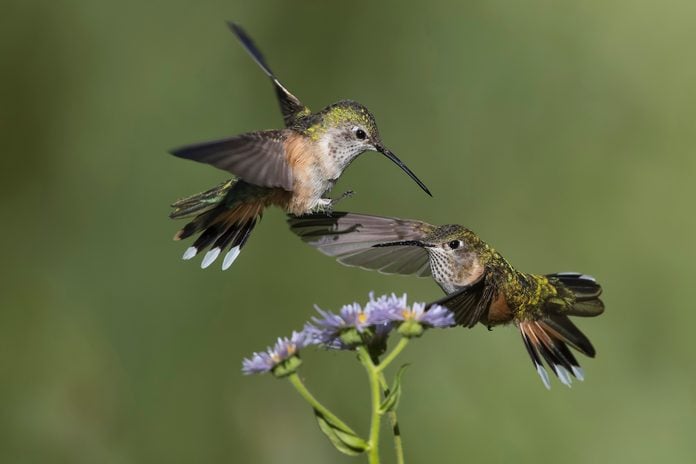
Male hummingbirds are very territorial and can be remarkably feisty about defending their food sources. It makes sense considering that flowers, their primary source of nectar, last for only a limited time. A hummingbird that stakes out a good patch of blooms may defend that finite resource with great gusto.
Hummingbirds, butterflies, bees and other pollinators each have a relationship with flowers that benefits both sides. Flowers produce nectar, which is rich in sugar, to attract these creatures. In turn, the birds and insects pick up pollen from one flower and carry it to another, helping the plant to reproduce. But each bloom produces only a small amount of nectar at a time. If a hummingbird finds a group of flowers, it may visit them one at a time, taking sips from each while waiting for the others to replenish.
A good flower patch might keep a hummingbird supplied with food all day—but only as long as the hummer can keep other fliers away. When a hummingbird finds a stand of wildflowers or a blooming tree or vine, it may be easier for the hummer to defend the plant against competitors than to find another nectar source.
So these birds have an instinct to quickly start protecting a feeding territory around the nectar supply they’ve discovered. It’s likely to be only temporary, and the hummingbird may soon shift to another spot, but the instinct to guard a food source is always there.
Why Won’t Hummingbirds Share a Feeder?

“I never get more than one hummingbird at a time at my feeders. How can I encourage them to share?” asks reader Cheryl Vandermark of Wallkill, New York.
When male hummingbirds defend one of your feeders, they’re exhibiting the same territorial behavior. A hummingbird’s territorial instinct is so strong that it often carries over to situations where it’s not as needed—for example, at hummingbird feeders with an endless supply of sugar water. Some individuals are more aggressive than others and therefore are more likely to dominate a single feeder.

Hummingbirds have an instinct to protect their food sources, because in nature, a patch of flowers will produce only so much nectar in a day. The tiny birds carry this defensiveness over to artificial feeders. So no matter how often you refill your feeder, the hummingbirds don’t realize that they don’t have to fight over it. One aggressive individual may try to dominate a whole row of feeders, zooming in to drive away every other bird.
The best solution is to put your sugar-water feeders farther apart, so one bird can’t control them all. Or better yet, put the feeders out of sight of each other, perhaps on different sides of your house or in spots separated by trees. If that isn’t possible, you may have an overly pushy solo hummingbird controlling your feeders until it decides to move on.
Pursuing a Mate

In the breeding season, a male hummingbird establishes a different kind of territory. He surveys his surroundings from a high perch. If another male shows up, he’ll chase it away. If a female hummingbird appears, he’ll start putting on his courtship display—often performing aerial acrobatics, with loud whirring or whistling sounds—to catch her attention. After they mate, though, that’s the end of their relationship, and he goes back to watching for more females.
When the female builds her nest, it may or may not be in his territory. In the meantime, she’ll defend a small territory of her own, chasing away other females that come too close to her nest.
Hummingbirds are a joy to watch, and they become even more fascinating when we understand the reasons behind some of their actions. You may get to observe these territorial behaviors in your own backyard.
How Do I Feed Multiple Territorial Male Hummingbirds?

To feed multiple male hummingbirds, you’ll need some space. Provide more than one feeder and grow nectar-rich native plants.
When setting up multiple feeders, try to place them at least 15 feet apart. If the layout of your outdoor space allows, put the feeders out of sight of each other. When the male hummingbirds can’t see each other, they won’t be as busy chasing each other away.
Also, to see more of these fliers, provide plenty of nectar plants that will supply shelter and help attract the small insects hummingbirds rely on for protein. Tube-shaped red and orange flowers are common hummer favorites. Visit your local native plant nursery and ask for their suggestions.
Hummingbirds Are Less Territorial During Migration

The intensity of their defense varies by season. In their nesting territories in summer, they may fiercely chase away all rivals. During migration, when they’re just passing through an area, they have less incentive to defend anything. Hummingbird festivals are usually held at migratory stopover sites, where large numbers of hummers may pause only briefly, tolerating each other’s presence while they swarm the feeders.
Are Female Hummingbirds Territorial?
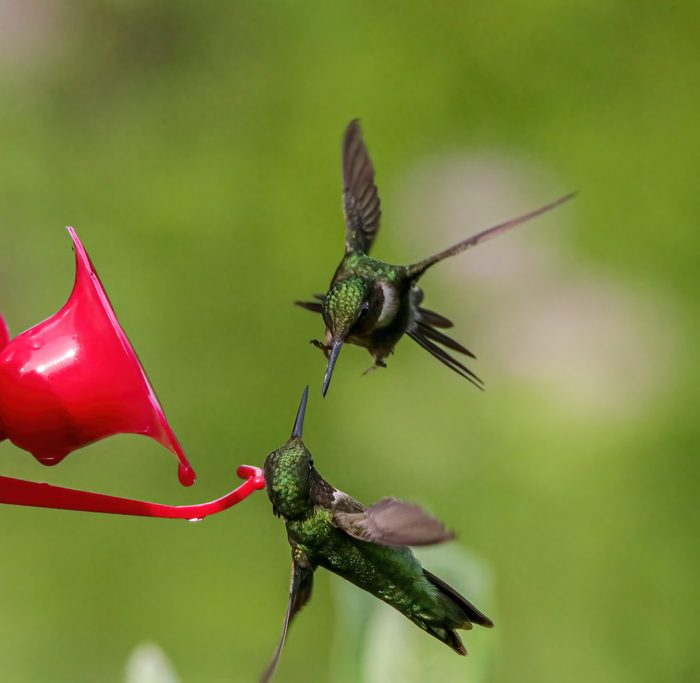
“One female hummingbird chases all other hummingbirds away from our sugar-water feeder. We’ve added several more feeders, but she keeps growing her territory. What should we do?” asks Sue Evanecko of Manorville, New York.
Individual birds vary in personality, and some hummingbirds are absurdly aggressive in defending food sources. When your feeders have been adopted by overprotective sprites, it’s a challenge to outwit them. If the layout of your yard allows, try positioning feeders on opposite sides of the house so it is impossible to see them all at once. Or place two or three feeders close together, and then another one as far away as possible.
The hyper-aggressive bird will probably move on in a month or two anyway. And for the future, planting more hummingbird preferred native flowers should reduce competition for the feeders.
Other Examples of Territorial Bird Behavior
Many birds have specific ways of keeping potential intruders out of their claimed spaces.
- Carolina wren pairs stay together to defend a permanent territory with songs and calls year-round.
- A male red-winged blackbird sings to announce a domain in the marsh for himself and his multiple mates, but only in the breeding season.
- Belted kingfishers protect feeding areas along rivers, chasing away other kingfishers that approach.
Why Trust Us
For nearly 30 years, Birds & Blooms, a Trusted Media Brand, has been inspiring readers to have a lifelong love of birding, gardening and nature. We are the #1 bird and garden magazine in North America and a trusted online resource for over 15 million outdoor enthusiasts annually. Our library of thousands of informative articles and how-tos has been written by trusted journalists and fact-checked by bird and garden experts for accuracy. In addition to our staff of experienced gardeners and bird-watchers, we hire individuals who have years of education and hands-on experience with birding, bird feeding, gardening, butterflies, bugs and more. Learn more about Birds & Blooms, our field editor program, and our submission guidelines.
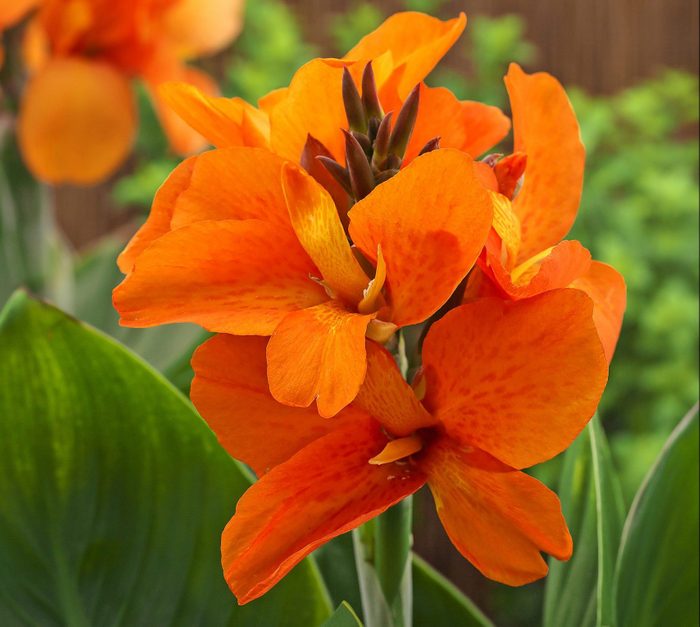
When we bought our home in Florida several years ago, we found several treasures in the otherwise bland backyard. As we dug up an area to create my native butterfly garden, we came across several large rhizomes, apparently dormant. We weren’t sure what they were, so for the time being, we popped them into a pot and waited to see what would happen. With a few months, our rhizomes had put on 5 feet of growth with giant leaves followed by brilliant pink blooms. We had found a treasure trove of canna flowers!
Get expert calla lily care and growing tips.
Canna Flower Care and Growing Tips
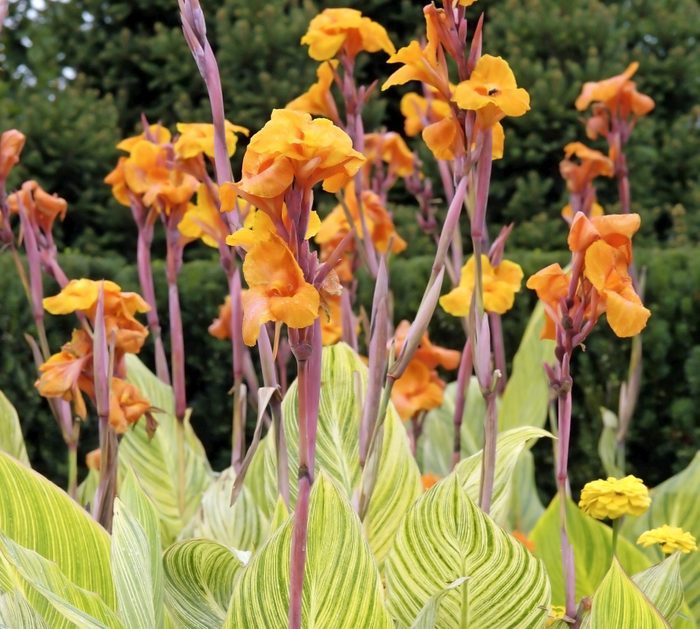
Canna flowers, sometimes called canna lilies, are semi-tropical plants that grow from rhizomes. They are native to the warmer areas of the Americas. Golden canna (Canna flaccida) is native in the southeast United States, but most cannas flowers you buy today are cultivars or hybrids of a variety other species. This has given us a wide range of colors and growth habits, including some that are only about 2 feet tall instead of 5 to 8 feet, like the native varieties. Plant cannas in the spring for summer blooms.
- Canna
- Zones 7 to 10 (sometimes zone 6 with protection)
- Full sun
- Moist, well-draining soil
Cannas need moist soil to perform well. They’re perfect for wet spots in the garden, such as an area where a downspout directs water. You can also plant taller varieties directly in water, up to about 2 feet deep. Choose a spot with full sun or partial shade, where these flowers can tolerate slightly drier soil in my experience.
Learn how to care for a peace lily plant.
Cannas Foliage

While the flower spikes are impressive in their own right, these plants are beloved for their foliage. The large, boldly colored leaves create a tropical effect when combined with other bright, flowering plants. Some varieties have bronze or even striped foliage.
These water lily flower pictures will take your breath away.
Overwintering Canna Plants
Cannas grow from fleshy rhizomes. In northern growing zones, dig them up in fall and overwinter in sawdust or peat moss in a cool, dry area. Replant the rhizomes next spring, after the threat of frost passes.

“This plant (above) popped up in our landscaping this summer. Our best guess is that it came with the mulch. What is it, and should it be removed?” asks Birds & Blooms reader Tom Paul of Naperville, Illinois.
Horticultural expert Melinda Myers says, “What a wonderful surprise to find a volunteer canna plant surviving the winter in northern Illinois! These plants are typically hardy to Zone 7, with the possibility of some surviving in Zone 6 when heavily mulched.
The new USDA Plant Hardiness map has areas of Naperville listed as Zone 6a and those further from Chicago as 5b. Perhaps a plant or portion of the rhizome was accidentally left in the ground over winter. The close proximity to your house provided a sheltered winter location and a bit of radiated heat for additional warmth.
Enjoy this lovely survivor and decide if you want to dig it up and store it indoors for winter or see if it will survive again in the garden.”
Canna Plant Pests
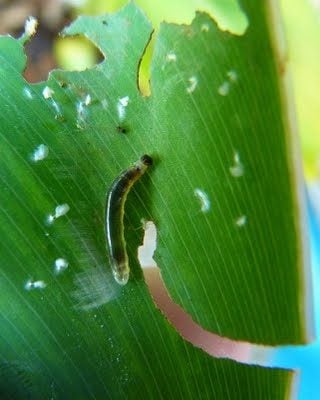
In their native areas, cannas can be afflicted by the leaf-rolling caterpillars of canna skippers (Calpodes ethlius). These little guys can do some real damage to the foliage if they’re not noticed right away, but usually won’t affect the flowering or overall health of the plant.
As soon as you notice signs of leaf-rolling, pull the leaf apart and remove the caterpillar inside. Drop it in in soapy water to kill it. You can also watch for eggs on the leaves and remove them first.
True lily vs daylily: what’s the difference?
Canna Flower Varieties
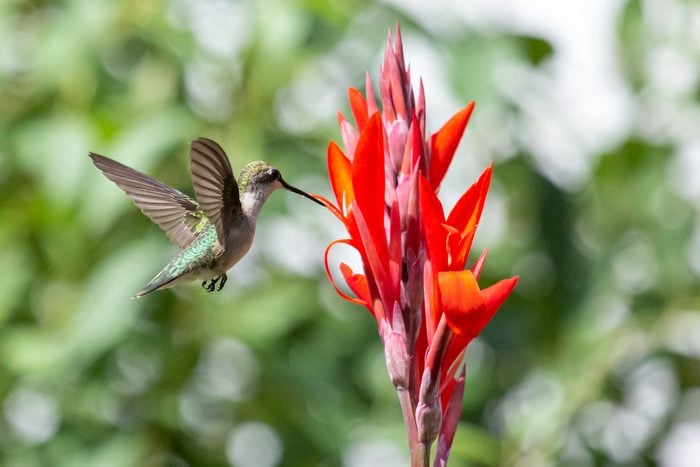
Hundreds of canna varieties are available. Try the vigorous, heat-loving South Pacific, an All-America Selections Winner with glowing orange flowers. This variety is grown from seed instead of rhizomes.
For gorgeous golden flowers, plant Toucan Yellow. Red varieties like ‘King Humbert’ will attract hummingbirds.
Next, learn how to grow Persian lily flowers for dark garden drama.
About the Expert
Melinda Myers is the official gardening expert for Birds & Blooms. She is a TV/radio host, author and columnist who has written more than 20 gardening books. Melinda earned a master’s degree in horticulture from the University of Wisconsin-Madison.
Sources
Why Trust Us
For nearly 30 years, Birds & Blooms, a Trusted Media Brand, has been inspiring readers to have a lifelong love of birding, gardening and nature. We are the #1 bird and garden magazine in North America and a trusted online resource for over 15 million outdoor enthusiasts annually. Our library of thousands of informative articles and how-tos has been written by trusted journalists and fact-checked by bird and garden experts for accuracy. In addition to our staff of experienced gardeners and bird-watchers, we hire individuals who have years of education and hands-on experience with birding, bird feeding, gardening, butterflies, bugs and more. Learn more about Birds & Blooms, our field editor program, and our submission guidelines.
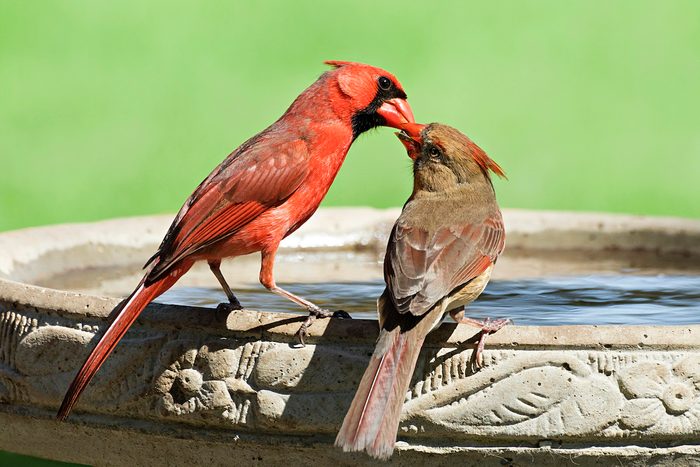
On This Page
Clean a Birdbath With Bleach
Janice Ruesch of Farport, New York, says, “I clean my birdbaths many times during the summer, but it seems like they’re not actually getting clean. What is the proper way to clean a birdbath?”
Birding experts Kenn and Kimberly Kaufman say, “Depending on the material your birdbath is made from, a mixture of water and bleach can be an effective cleaning solution. If you’re in doubt about how well the material will hold up, be sure to test a small area first before cleaning the whole bird bath.”
Did you know: Changing the water in your birdbath every few days will help keep algae from growing, making it easier to clean in the long run.
Learn how (and how often) to clean bird feeders.
How to Clean a Concrete Birdbath
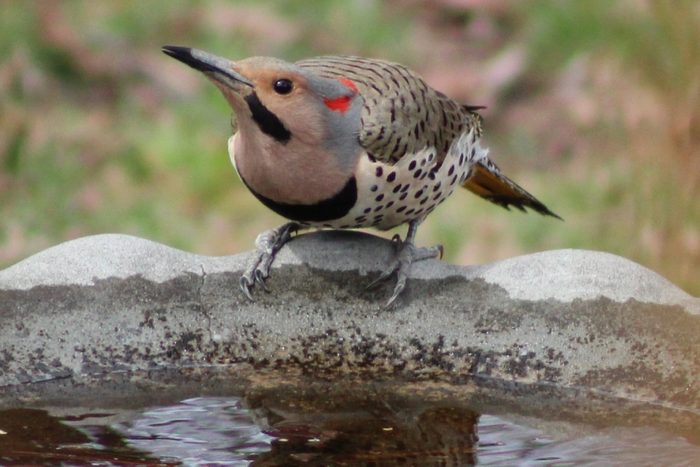
- If the birdbath is made of concrete, empty out the water.
- Using a hose with a high-pressure nozzle, spray off any built up algae or dirt.
- Add water to the birdbath until it’s almost full. Then add 1 to 1 1/2 cups of bleach.
- Cover the entire bath with a black trash bag to prevent any birds from getting to the bleach water.
- Allow it to soak for 10 to 15 minutes.
- Remove the plastic bag.
- Carefully drain the bleach water mixture in a safe area.
- Then rinse the bath for a few minutes with fresh water until you can no longer detect the smell of bleach.
Learn how to attract birds to use a bird bath.
How to Clean a Birdbath With Vinegar
You can also freshen up your backyard birdbath in a snap with vinegar. Just rinse off the surface and scrub out the basin with nine parts water to one part vinegar.
Learn how to repair a cracked birdbath.
How to Keep Algae out of a Birdbath
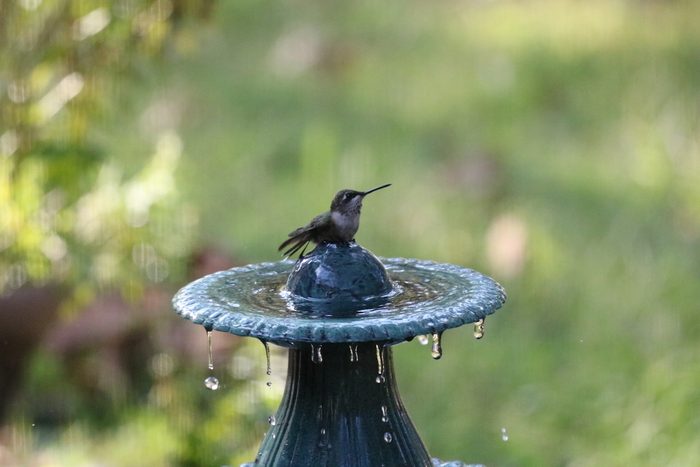
Patricia Sparks of Helendale, California, asks: “I’m careful to properly clean my birdbaths, but algae is still a problem. What should I do?”
Kenn and Kimberly Kaufman say, “Algae grow in standing water. It’s important to clean and change the water in birdbaths every few days. In hot weather, we change the water in our birdbaths every day, scrubbing with a stiff brush and rinsing thoroughly before refilling.
If algae continue to be a problem after proper cleaning, you might need to move your birdbaths to a different location. It’s best to keep them out of full sun. But avoid putting them directly under trees or shrubs where plant parts may drop directly into the water.
Moving water also helps prevent algae, so consider adding a solar fountain or dripper, which will help attract more birds too.”
“Is there a product to reduce algae growth in water fountains while also being safe for birds, tree frogs, toads and other small animals that drink from them?” asks reader Karen Zwicker of Litchfield, Illinois.
Kenn and Kimberly say, We don’t favor chemicals to control algae. Their effects on wildlife may not be fully known. Regular cleaning is a safer approach.”
Next, learn how to clean hummingbird feeders.
About the Experts
- Kenn and Kimberly Kaufman are the official birding experts for Birds & Blooms. They are the creators of the Kaufman Field Guide series and they speak and lead birding trips all over the world.
Why Trust Us?
For nearly 30 years, Birds & Blooms, a Trusted Media Brand, has been inspiring readers to have a lifelong love of birding, gardening and nature. We are the #1 bird and garden magazine in North America and a trusted online resource for over 15 million outdoor enthusiasts annually. Our library of thousands of informative articles and how-tos has been written by trusted journalists and fact-checked by bird and garden experts for accuracy. In addition to our staff of experienced gardeners and bird-watchers, we hire individuals who have years of education and hands-on experience with birding, bird feeding, gardening, butterflies, bugs and more. Learn more about Birds & Blooms, our field editor program, and our submission guidelines.
“Do birds reuse their nests? asks Birds & Blooms reader Liza Peniston of Augusta, Kansas. The short answer is that it depends on the species. Some large birds may use the same nest for years, but most, like robins, opt for new sites every time. There are endless variations in bird behavior.
On This Page
Bird That Do Not Reuse Nests
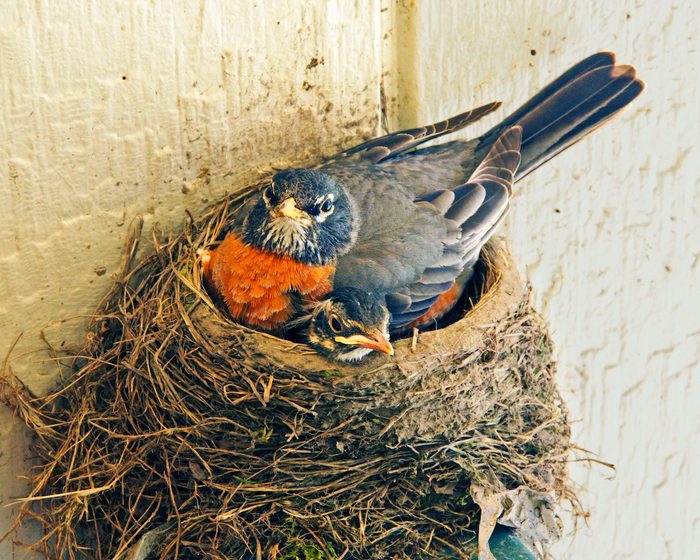
As a very general rule, smaller birds usually make their nests for a single use, especially those that build nests in the open. Most multi-brooded birds do not reuse nests because the materials are not durable enough to last through more than one brood. For instance, mourning dove nests are often flimsy and often fall apart, because the birds build them so quickly.
A lot of factors go into whether individual birds will lay eggs more than once per year. “Many species can renest if attempts fail early in the breeding season, and some regularly produce multiple broods annually,” says Sarah K. Winnicki, a Ph.D. candidate in avian evolutionary ecology at the University of Illinois Urbana-Champaign. For example, American robins may have up to three broods in one season and typically build a new nest for each brood.
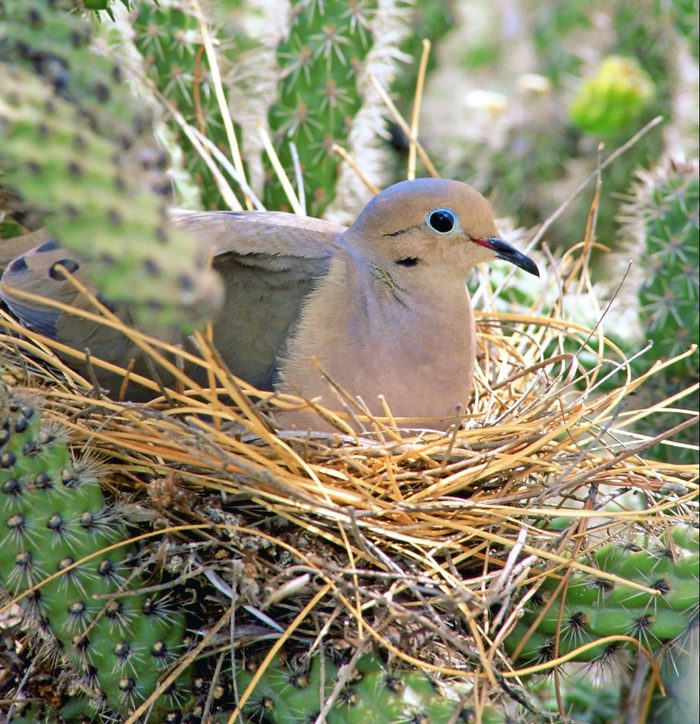
Birds most often pick a different location for later nesting sites, even after successful attempts. One grasshopper sparrow monitored by Sarah moved over 3 miles between nests. For the most part, songbirds abandon their nests after the breeding season. A few, especially cavity nesters, might return to roosting sites, but they don’t generally use the same hollows.
What types of birds mate for life?
Do Hummingbirds Reuse Their Nests?
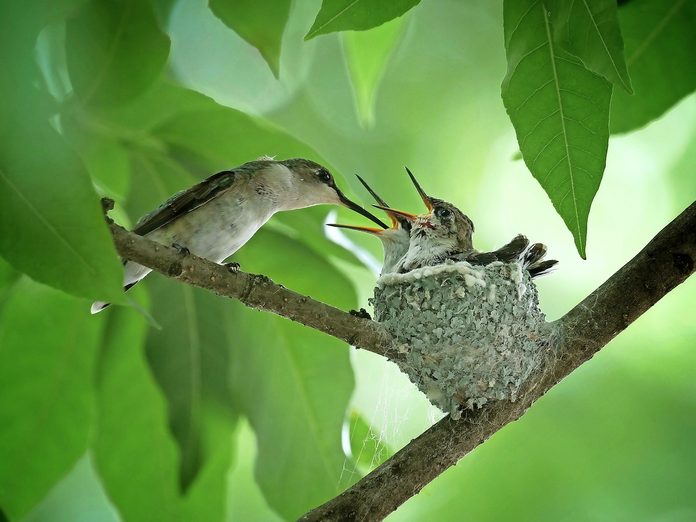
Hummingbird nests are not also durable enough for repeated use. Typically the female hummingbird will build a new nest for each brood, even within the same year. She may start construction before she finishes feeding the full-grown young from a previous one. In rare cases, a location is so good that females will build right on top of the remains of the old nest.
Psst—here’s what to do if you find a nest, eggs or baby bird.
Birds That Do Reuse Nests
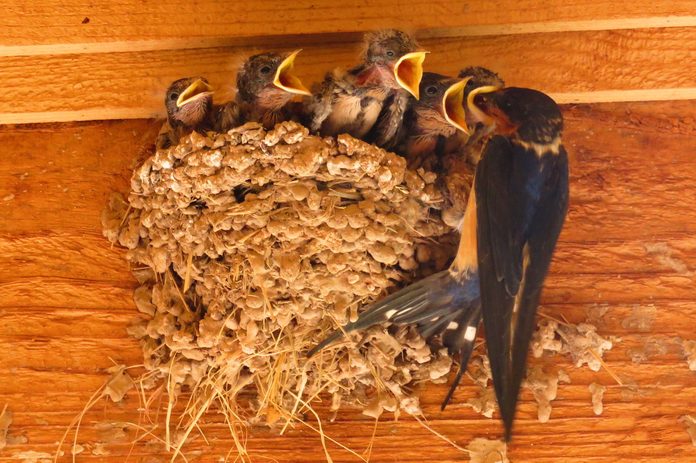
But birds that build nests in enclosed spaces, such as bluebirds or house wrens that use tree cavities or birdhouses, are somewhat more likely to use those spots for a second brood. Barn swallows may reuse an old nest, cleaning out some of the debris from the first brood and adding a new layer of mud to the rim. Other songbirds occasionally reuse a nest if it’s in good shape.
Large birds like eagles or herons may reuse the same nest, but these species only raise one brood per year.
Do Birds Live in Nests Year-Round?
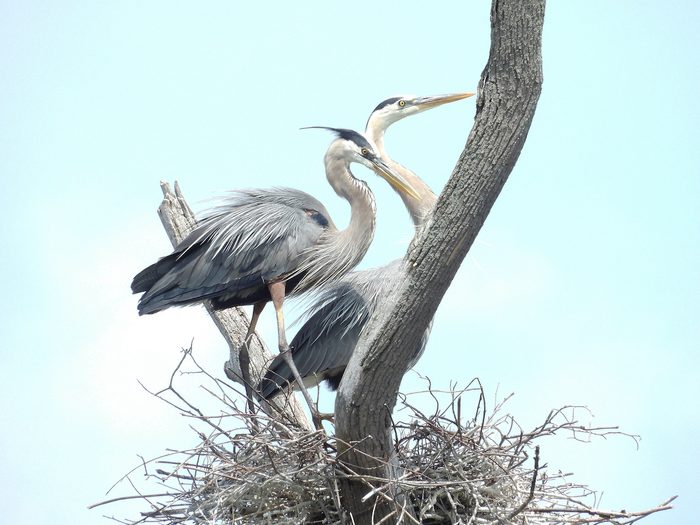
“How long do birds live in their nests?” asks reader Linda Johnson of Del Rio, Texas.
Birding experts Kenn and Kimberly Kaufman say, “In general, birds don’t live in their nests the way people live in their houses. For most birds, the nest is like a cradle: a place to incubate their eggs and feed their hatchlings until those baby birds fly away. Then the nest is usually abandoned and never used again, and the parents build a new nest for their next attempt.
Some large birds such may use the same nest year after year, and some hole-nesting birds such as woodpeckers and chickadees may sleep in those holes at night year-round. But in most cases, the nest is simply a temporary child-care structure.”
Next, learn about different types of bird nests and how to identify bird eggs by color and size.
About the Experts
- Sarah K. Winnicki is is an avian biologist and PhD candidate at the University of Illinois Urbana-Champaign. Sarah’s research focuses on growth rates of songbirds like American robins, and their past research has focused on environmental impacts on growth rates of songbirds in the grasslands.
- Kenn and Kimberly Kaufman are the official birding experts for Birds & Blooms. They are the creators of the Kaufman Field Guide series and they speak and lead birding trips all over the world.
Why Trust Us?
For nearly 30 years, Birds & Blooms, a Trusted Media Brand, has been inspiring readers to have a lifelong love of birding, gardening and nature. We are the #1 bird and garden magazine in North America and a trusted online resource for over 15 million outdoor enthusiasts annually. Our library of thousands of informative articles and how-tos has been written by trusted journalists and fact-checked by bird and garden experts for accuracy. In addition to our staff of experienced gardeners and bird-watchers, we hire individuals who have years of education and hands-on experience with birding, bird feeding, gardening, butterflies, bugs and more. Learn more about Birds & Blooms, our field editor program, and our submission guidelines.


